What are the steps to finding the best pressure sensor for a particular application? That’s a challenge faced by many a young engineer just out of school. Engineering school teaches a great deal of theory, but what is the best way to choose when so many things that affect the decision are not obvious, and not necessarily part of the formal curriculum? This article reviews a series of questions and other considerations that help guide the engineer in making critical decisions regarding pressure applications.
Why measure pressure?
The first question is the most basic: What is the purpose of the measurement? There are generally three reasons for taking a pressure measurement: monitoring, control and safety. While much of the same hardware is used in all three, there are significant differences. The purpose of a monitoring point is to keep the operator informed, but not to close a control loop; this is the least critical of the three. A control point provides an input to a control system, and requires the greatest accuracy, while for a safety point the most important parameters are reliability and keeping users safe.
What pressures are involved?
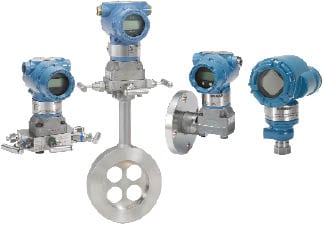 |
| Figure 1. Pressure transmitters are supplied in many configurations |
An important question to ask early on is, what is the normal working pressure? That range of pressure should fall within the device’s most accurate range. What are the highest and lowest pressures expected during normal operation? Accuracy can generally degrade somewhat at the extremes, but the device must remain repeatable under these conditions, and must not suffer any damage, nor require recalibration. It is also vital to know the maximum pressure the device will experience, for safety reasons. It must be able to withstand a pressure as high as the pressure rating of the vessel or pipe to which it is attached without bursting — and that means all attached piping, flanges manifolds and other accessories that will be exposed to pressure must be rated to a minimum threshold. Some devices can continue to operate after such an overpressure incident and retain accuracy, while others may need recalibration or even replacement, but the primary consideration here is safety.
What accuracy is required?
Control applications generally need more accuracy than monitoring applications, while, with safety applications, reliability is key. The exact level of accuracy needed depends entirely on the needs of the process and application being measured.
How to connect to the process?
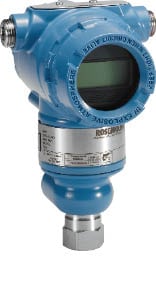 |
| Figure 2. An in-line mounted transmitter has a single connection to the process (for gage or absolute pressure) at the bottom of the unit |
Because pressure transmitters are also used in flow, level or pressure applications, they are often integrated with other components (Figure 1). An in-line mounted transmitter (Figure 2) has a single connection to the process (for gage or absolute pressure) at the bottom of the unit. An in-line mounted transmitter is light in weight and may require no mounting bracket. A coplanar mounted transmitter (Figure 3) has two process connections for differential pressure (DP) on the bottom of the unit. This transmitter is light in weight and is installed on a single process flange. This connection type is more modern than the biplanar connection. The coplanar connection enables measurement of differential, absolute and gage pressure applications. A biplanar connection is a more traditional way of connecting to the process (Figure 4) and has two ports on the side of the lower part of the unit. This is the original process connection used for DP measurement; it supports gage, differential and absolute pressure measurements. It is heavier and more challenging to connect than in-line or coplanar designs. A transmitter used in a DP flow application can also be mounted directly to a flange containing an orifice plate, as shown in Figure 1 (second from the left). When considering a connection type, one should ask: is there a process connection point available, or will it be necessary to add a connection point or tap into the process? Either of these may require a process shutdown, which can be costly and potentially dangerous. It is also possible to hot tap a process, a procedure that requires highly trained personal, but can keep the process up and running. A new connection is usually put in place during scheduled downtime or if the location can be bypassed. Other things to consider regarding the connection are as follows: • Can a flange be added to make the connection? If so, what type of flange is appropriate for the application? • What threading is present? • Is a shutoff valve available? It is often impossible simply to put a pressure measurement point wherever you want it; you can put it in only where access is available. This may be 30 ft down the pipe from where you thought you were going to be able to put it as opposed to putting it right on the vessel itself, and thus may require a remote display to be visible to operators. All of the mounting considerations for a monitoring point, plus several more, also apply to a control point. For control, you typically will need to have a connection that is more maintainable. There may be sediment buildup, so it is important to be able to clean out and purge the connection point. If a manifold will be needed, it may require more frequent bleeding, which means a bleedable flange will be needed, or a three-way or five-way valve manifold. It is often a good idea to make sure the final element is close-coupled to minimize buildup of sediment in the connection. In a DP flow application, for example, integrated orifice meters are available (Figure 1, second from the left). Close-couplings also help to minimize leak points. A flush still may be required. Also, in DP flow applications, it is vital to take flow conditioning into consideration. In retrofits, for example, there is seldom sufficient room for a straight pipe run to reduce the process turbulence in order to make a good pressure reading. In this case, conditioning orifice plates can be utilized. These can make it possible to install orifice plates within a few pipe diameters of an elbow or other feature that would otherwise prevent laminar flow.
Wet leg or wet-leg/dry-leg?
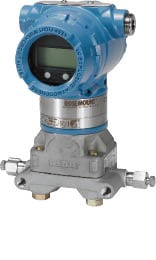 |
| Figure 3. A coplanar mounted transmitter has two process connections (for differential pressure) on the bottom of the unit |
Traditional DP measurement requires impulse piping connected to the high- and low-pressure sides of the process vessel or tank. In the traditional wet-leg/dry-leg arrangement used for measuring level in vessels and tanks, the high pressure side (the wet leg) is filled with process fluid, while the impulse line on the low pressure or reference side (dry leg) is filled with vapor (although it can also be filled with a non-reactive gas). In gas service, the process tap should be on the top side of the pipe, and the transmitter mounted above the pipe, with the impulse line (the dry leg) sloping upward; this is to make sure that any condensation in the impulse line will drain back to the main pipe. In liquid service, the situation is reversed; the tap should be on the bottom of the pipe, the transmitter mounted below, and the impulse line (the wet leg) sloping down to it, so any gas in the impulse line can get back to the pipe. In steam flow service, the impulse lines are kept filled with condensate, to keep hot steam from reaching and damaging the transmitter. In cold areas, these impulse lines require insulation and heat tracing to prevent freezing damage from condensate. This is expensive and can be a maintenance concern. A wet leg requires a constant level of liquid within the tubing for a reliable measurement. If the liquid evaporates, the DP measurement will drift. A dry leg must be kept free of condensation. If process vapors condense into the dry-leg tubing, the DP measurement will drift. Evaporation or freezing of the liquid in the wet leg and condensation in the dry leg can hurt accuracy and requires a fair amount of maintenance. One solution for steam service in cold climates is to replace the separate orifice plate and DP meter with a single device combining the element (generally either an averaging Pitot tube, for example an Annubar, or a compact wafer-style primary element with the orifice plate integrated with the manifold) with the DP transmitter mounted above the steam line. This eliminates the impulse lines and solves the freezing problem. For food-and-beverage applications, process material can be trapped in the impulse lines and allow bacteria to grow. In other cases the process material may tend to cause plugging in the impulse lines.
Remote seals
One solution to plugged impulse lines is often a remote seal and capillary system (also known as a chemical seal, diaphragm protector or diaphragm seal system; Figure 5). This consists of an external sensing diaphragm. Process pressure is transmitted to the pressure sensor via an oil-filled capillary. The system acts as an extension of the pressure transmitter and protects the transmitter diaphragm from hot, cold or corrosive processes, as well as viscous materials or those containing suspended solids that might plug impulse piping. In hygienic applications, remote seals also allow for easier cleaning of the process from the connections to avoid contamination between batches. And it avoids maintenance often needed with wet-leg and dry-leg installations. There are also electronic remote-sensor arrangements for measuring tank level. Instead of having a single DP transmitter installed with connections to the bottom and top of the tank (the former for measuring the level and the latter to provide the reference pressure), two transmitters are used. One is located at the bottom of the tank, with the other one at the top. The two sensors are connected electronically, instead of mechanically, via a wet-leg/dry-leg or capillary (Figure 6). This is useful for tall tanks because it eliminates the need for long impulse lines. A caveat to this method is that accuracy is impacted in tanks with high blanket pressures relative to the DP measurement for level. When considering such an arrangement, it is best to consult a factory expert to help select the best technology.
Environmental considerations
Operating temperature is a vital consideration. If using a remote seal system, be sure to choose a fill fluid compatible with both the process temperature and the ambient temperature. At low temperatures, impulse lines can freeze, or the fill fluid can gel. At high temperatures, the fill oil in a remote seal system can boil or degrade. There are fill fluids that can withstand high temperatures, but some of these have limited low-temperature ranges. Will there be significant mechanical vibration? Transmitters should always be installed to minimize vibration, shock and temperature fluctuations. Does the process involve significant pressure pulsation (for example, at the discharge end of a positive-displacement pump)? Rapid pulsation degrades measurement accuracy and, if it continues for long periods, can wear out the pressure-sensing element. A pulsation damper or snubber may be required. This can be as simple as a porous metal filter or an adjustable needle valve inserted in the impulse piping. In general, strain gage and capacitive sensors are more resistant than other types to the wear and tear from highly pulsating processes. Will the device be used in a hazardous area? If so, what approvals will be required? Relevant approvals can include ATEX, IECEx, CSA and Factory Mutual (FM), for starters. Many devices are available with combination approvals that make them suitable for a variety of hazardous areas. In food-and-beverage and pharmaceutical applications, remember that the transmitter may be subjected to spraydown/washdown with hot and aggressive chemicals, and must be rated for such service.
Maintenance considerations
It is important to know how often the transmitter will need recalibration, and what will be involved in doing that. It may require that the device be physically removed and sent to an instrument laboratory, which, depending on the way it is installed, may require a process shutdown. If the transmitter can be isolated with shutoff valves, the disruption will be considerably reduced. In addition, some transmitters now can offer longer stability specifications, thus reducing maintenance costs in some applications since they require fewer calibrations.
Intelligent transmitters
 |
| Figure 4. A biplanar connection has two ports on the side of the lower part of the unit. It supports gage, differential and absolute pressure measurements. It is heavier and more challenging to connect than in-line or coplanar designs |
Many of today’s intelligent process transmitters contain a great deal more information than simply the pressure reading; this can include temperature, the device history, range-setting information and more. An intelligent transmitter can detect internal problems, allow the unit to be recalibrated and re-ranged remotely and in some cases even spot process anomalies and plugging of the impulse lines. Some interesting work is being done based on using the raw, high-speed data coming directly from the transmitter’s sensing element before it is smoothed and filtered for delivery to the control system. There are a number of ways this additional information can be made available, as discussed below.
Pressure measurement principles A pressure transmitter measures the pressure of a gas or liquid and relays that information back to a control system. This differentiates it from a pressure gage, which gives only a local indication and does not communicate.
Gage, absolute or differential?
Any pressure measurement is by definition made against a reference pressure. In a gage measurement (expressed, for example, as pounds per square inch gage, or psig) the reference is ambient atmospheric pressure. An absolute pressure measurement (psia) measures against vacuum, while differential pressure (DP) measures the difference between two pressures. While the uses of gage and absolute pressure measurements are generally fairly straightforward (what is the pressure in the vessel?), differential pressure measurement has much wider application. It is used in flow measurement, to measure the pressure drop across an orifice plate or other device. DP is also used in level measurement, to measure the depth of liquid in a tank: if the density of the liquid is known, its depth can be calculated. But since many tanks are not at atmospheric pressure (for many reasons, including the vapor pressure of the liquid in the tank), a DP gage is used, with one side connected near the bottom of the tank and the other near the top, above the surface of the liquid.
Parts of a pressure transmitter
The major parts of a pressure transmitter are the pressure-sensing element, which transforms pressure input to an electrical signal, an isolating diaphragm and a housing that includes the necessary electrical interfaces. Sensing element. There are three main types of pressure sensors in common use in these applications. In a capacitive sensor, a diaphragm is one plate of an electrical capacitor. An electronic circuit detects changes in the capacitance as the diaphragm flexes under pressure. In a vibrating wire sensor, a wire that vibrates at its natural frequency is connected to a diaphragm. Changes in force on the diaphragm change the tension in the wire and hence its frequency. The electronic circuit that drives the vibration detects the change in frequency and outputs it as a pressure reading. In a piezoresistive sensor, a strain gage placed on a diaphragm changes its resistance as the diaphragm flexes with pressure changes. In many modern sensors the sensing element is contained on a silicon microchip. Isolating diaphragm. With the exception of simple applications (measuring the pressure of air or a noncorrosive gas), it is imperative to keep the process medium from reaching the pressure-sensing element. This is most commonly done with an isolating diaphragm. Isolating diaphragms are available in a variety of materials to meet the needs of different process fluids. As pressure is applied to the process, the isolating diaphragm flexes and transfers the pressure to the internal pressure-sensing element via a small volume of oil. The pressure sensor then transforms the pressure input to an electrical signal. Module housing. The pressure sensor is protected by the module housing, which supports the isolating diaphragms, protects the pressure sensor and provides an electrical connection for the transmitter housing. Transmitter housings are available in three basic configurations for different applications. The dual-compartment housing is the most common type. It separates the terminal block from the output electronics. It allows for advanced functionality and allows for use of either an LCD display or a local operator interface. A single-compartment transmitter housing is less common. It contains just a wiring termination and junction box housing. A quick-connec t transmitter housing is compact and lightweight, and simplifies field wiring. â
Choices of transmission media
Analog. The simplest and most common way for a transmitter to deliver its output is analog, via a 4–20-mA current loop: 4 mA indicates the bottom of the device’s range and 20 mA the top; the 4 mA value is used to ensure that zero current will be seen as an indication of loop failure, not a reading of zero; the 4 mA is also sufficient to power the transmitter. There have been, and are, some competing analog standards, like 10–50 mA (now obsolete) and 0–20 mA, but they are seldom seen. There are 1–5-V systems, but they are used in only a few applications, such as low-power installations. Use of a current loop requires that each transmitter have its own wire pair leading back to the control room (a distance that can reach a mile or more, in some facilities), plus its own input point in the control system, which adds significantly to the cost of adding additional measurement points to a facility.
HART. There is much more information available in today’s transmitters than just the process variable output, and in the 1980s the HART (Highway Addressable Remote Transducer) protocol became available. HART superimposes a small alternating component on the 4–20-mA output, with information carried by frequency-shift keying: 1,200 Hz indicates a digital 1 and 2,200 Hz represents a 0. Since this carrier signal sums to zero over time, it has no effect on the 4–20-mA loop. The HART signal allows two-way communication between the control system (the “master,” in networking terminology) and the transmitter (the “slave”) at a speed of 1,200 bits/s. As stated by the HART Foundation (Austin, Tex.; www.hartcomm.org), which controls the specification, “The digital signal contains information from the device including device status, diagnostics, additional measured or calculated values, [and so on]. Together, the two communication channels provide a low-cost and very robust complete field communication solution that is easy to use and configure.” [1] A handheld communicator can also be connected to a transmitter for local setup and maintenance purposes. HART has the advantage of using the existing 4–20-mA field wiring, which makes it simple and inexpensive to set up. But this is also a disadvantage. Because HART uses a separate 4–20-mA loop for each transmitter, it is expensive to add additional transmitters to an existing system. There is also a multidropped version of HART in which there are no 4–20-mA loops; all transmitters connect to the same cable, which carries sufficient current to provide 4 mA to power all the connected devices, and all process-variable data are sent digitally in response to interrogations from the master; though this architecture is seldom utilized. A wireless-HART protocol is also available, as discussed later in the article.
Digital fieldbuses. Since the mid-1980s, numerous networks that can be classified in computer terms as local area networks have been introduced; currently in the process control field the most popular are Foundation Fieldbus and Profibus PA. There are many others used in discrete control applications and office communications, including Ethernet, MAP, CANbus and more, but these are outside the scope of this article. Digital fieldbuses make available a great deal of information inside the connected field devices; this can greatly speed diagnostics. But one of the biggest advantages of digital field buses is that they greatly reduce the expense of adding additional field devices; because field devices are tapped into a single cable, the cost of a separate cable for each field device is eliminated. Foundation Fieldbus. Foundation Fieldbus is controlled by the Fieldbus Foundation (Austin, Tex.; www.fieldbus.org). While there are two versions of Foundation Fieldbus (with more on the way), the one used in process control applications, and the most common implementation for transmitters is an H1 segment design. This uses a two-conductor cable with devices multidropped from it, and is entirely digital. It uses a peer-to-peer protocol: devices can communicate with each other without a host, and they can initiate communications without a specific host command. For example, if one device experiences a problem, it can send an alarm.
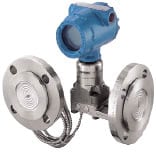 |
| Figure 5. A remote seal and capillary system consists of external sensing diaphragms (which can be flush or extended, as shown) mounted to the process and connected to the DP transmitter either directly or via oil-filled capillaries |
Because Foundation Fieldbus uses a peer-to-peer protocol, individual devices (valve actuators, for example) can contain control software (function blocks) and make decisions based on data from other field devices. This makes it possible to set up truly distributed control, often called control in the field, although such arrangements should be attempted only by those with a great deal of experience.
Profibus. Profibus is controlled by Profibus and Profinet International (PI; Karlsruhe, Germany; www.profibus.com). Like Foundation Fieldbus, Profibus devices are multidropped from a two-conductor cable. There are several versions of Profibus for different purposes; the one most used in the process industries for transmitters is Profibus-PA (The name Profibus originally meant Process Field Bus, and the PA is for Process Automation). Profibus-PA uses a master/slave protocol: individual devices respond only when interrogated by the central master. Both Foundation Fieldbus H1 and Profibus-PA provide a data rate of 31.25 kbits/s, have a maximum cable length of 1,900 m, and can support up to 32 devices per cable segment; though often device counts are much lower on the segment to support hazardous-area installations as well as bandwidth and expansion requirements. Power is supplied to the field devices over the cable.
Have you considered wireless?
One way to substantially reduce wiring costs for transmitters is to skip all wired connections, analog or digital, and use a wireless system. Alternatively, wireless can be used to add capabilities to an existing wired system: While HART is an industry standard, of the 30 million wired installed HART instruments, less than 10% have remote access to secondary data (checking and re-ranging are done with handheld units). There are now wireless adaptors that can be plugged into a HART-equipped 4–20-mA transmitter and make it part of a wireless network, unlocking configuration data, status information, calibration dates, and process data, both the main PV output and internal data like temperature — without having to walk out to the transmitter to check it.
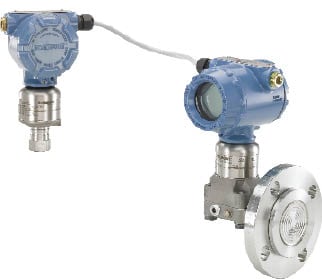 |
| Figure 6. An electronic remote sensor arrangement replaces a single DP transmitter with two sensors, one located at the bottom of the tank and one at the top. This is useful for tall tanks because it eliminates the need for long impulse lines |
WirelessHART. While the first wireless networks in plants were almost exclusively for asset monitoring purposes, the advent of IEC 62591 (WirelessHART) made wireless delivery of process-variable information increasingly common for monitoring and control applications. An IEC-approved WirelessHART system takes the form of a self-organizing mesh network, with a wireless gateway as its connection point to the plant’s main control system. Each transmitter constitutes a network node that acts as both a source of data and as a router, so that a message from one node will be passed from node to node until it reaches the gateway, and a message from the gateway to a particular node will similarly be passed via multiple paths in the mesh from node to node until it reaches its intended recipient. The redundant paths provide for reliable communications; not dependent on a single path for communication. The network is also self-healing: if one node is disabled, network traffic will be automatically routed around it to ensure delivery. The arrangement also allows the network to extend over a larger geographic area than the radio range of the individual nodes. A node does not have to be within radio range of the gateway, it just has to be in range of one or two other nodes in the system.
Advantages. One of the major advantage of wireless is that it does not require any new I/O points. Expanding a plant, or just adding transmitters to an existing system, generally requires a new I/O. A wireless network makes it possible to expand a plant’s instrumentation without running any wiring at all (4–20 mA or even fieldbus cabling). One simply connects the gateway to the control system. The additional wireless transmitters can be battery-powered and exist as nodes on the wireless mesh network adding the required process information.
Data rates. While wired HART operates at 1,200 bits/s, IEC 62591 (WirelessHART) operates at 250 kbits/s, although the rate at which data are delivered over time is considerably slower. This is because a WirelessHART transmitter does not send data continuously; to do so would quickly exhaust the battery of a battery-powered unit. For many networks, an update rate of several times per minute is sufficient, and can allow battery life from months to years. In some applications (tank-farm-level monitoring, for example), the update rate can be even lower under most conditions. And for such applications with slowly changing variables it is possible to include the wireless link as part of a control loop. Some wireless devices can update at a rate of once per second, which can be similar to some wired devices.
Some final thoughts
As in any field, there are many things to consider when it comes to selecting a pressure transmitter. Many of these considerations are not covered in engineering school, and are best learned on the job — preferably, by learning from more experienced engineers. One way to get a great deal of helpful information is to ask an application engineer from a major instrumentation vendor; many of these people have upwards of 30 years of experience in the field, and have seen and dealt with situations beginners have not imagined. They can often provide what amounts to free consulting services in terms of technology selection. We hope that this article will help you know what questions to ask. Edited by Gerald Ondrey
References
1. HART Communication Foundation, Austin, Tex. en.hartcomm.org/hcp/tech/ aboutprotocol/aboutprotocol_how.html
Author
 Wally Baker is currently a marketing manager for the Worldwide Pressure Product group of Emerson Process Management (8200 Market Blvd., Chanhassen, MN 55317; Phone: 952-949-7242; Fax: 952-949-5068; Email: [email protected]), and is responsible for Rosemount Wireless Pressure Products. He has 15 years experience in industrial process and control. While at Emerson he has held positions as Global Wireless O&G business development manager, sales and marketing manager for Asia Pacific Wireless & Plantweb, global product marketing manager in the Rosemount Temperature Business Unit, and spent five years in the Rosemount Pressure Engineering & Design team as an electrical and software engineer. Baker holds an E.E. degree from Iowa State University and an M.B.A. from the University of Minnesota.
Wally Baker is currently a marketing manager for the Worldwide Pressure Product group of Emerson Process Management (8200 Market Blvd., Chanhassen, MN 55317; Phone: 952-949-7242; Fax: 952-949-5068; Email: [email protected]), and is responsible for Rosemount Wireless Pressure Products. He has 15 years experience in industrial process and control. While at Emerson he has held positions as Global Wireless O&G business development manager, sales and marketing manager for Asia Pacific Wireless & Plantweb, global product marketing manager in the Rosemount Temperature Business Unit, and spent five years in the Rosemount Pressure Engineering & Design team as an electrical and software engineer. Baker holds an E.E. degree from Iowa State University and an M.B.A. from the University of Minnesota.